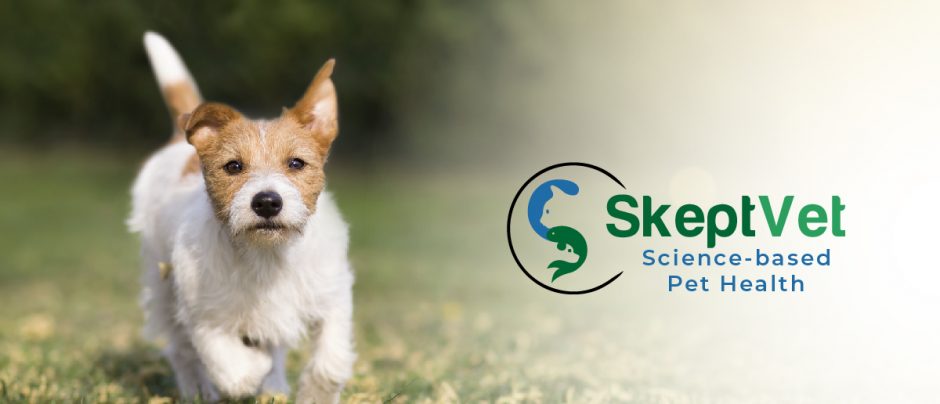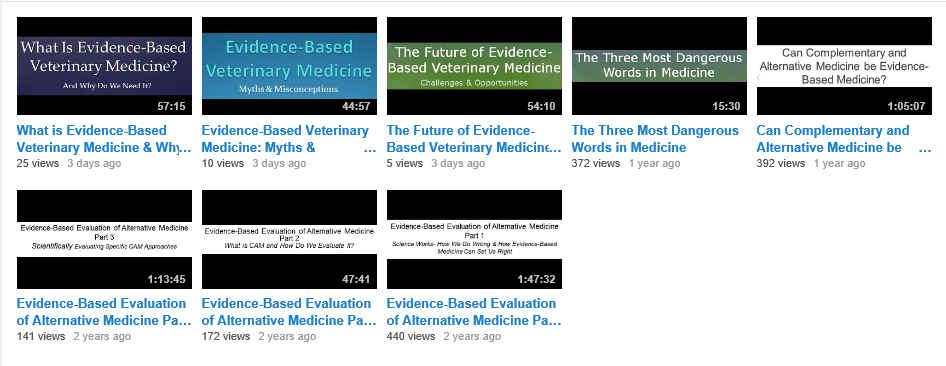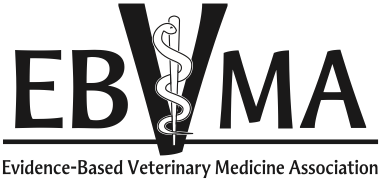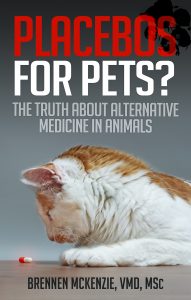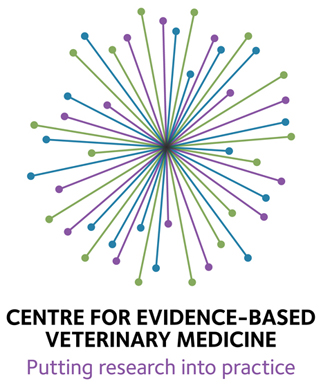In response to my criticism of individuals offering or promoting alternative medicine for pets, it has been pointed out that the community of such vets is diverse, and that one cannot fairly assume that all share the beliefs or practices of the more extreme members. That is undoubtedly true, and there are certainly individuals who claim to be “holistic” or “integrative” doctors who still have a basic commitment to the scientific method and with whom I agree on the merits or lack of merits for specific practices.
However, the whole raison d’etre of so-called complementary and alternative veterinary medicine (CAVM) as a category is to argue for special treatment for some therapies, and usually to suggest some either cannot or should not be expected to meet the scientific standards of evidence expected for conventional medical practices. The category itself is an ideological and political one which incorporates many ideas that are incompatible with the philosophy and practice of science.
And regardless of the diversity of the CAVM community, this community acts as a body to influence the practice of veterinary medicine. Much of this action happens through the membership organizations that bring together CAVM practitioners in general and proponents of specific therapeutic approaches.
I have often written about the Academy of Veterinary Homeopathy (AVH), the American Holistic Veterinary Medical Association (AHMA), and the American Holistic Veterinary Medical Foundation (AHVMF), organizations which represent many CAVM practitioners and which have had clear influence on the veterinary profession. These organizations may not speak for all CAVM practitioners, but they clearly represent many, and they are the voice and advocacy tool by which the CAVM community speaks to the rest of the profession and the public. Some of the actions such groups take and the ideas they espouse are troubling to those of us committed to science-based medicine.
For example, the AVH and AHVMA worked together to help defeat the resolution before the American Veterinary Medical Association (AVMA) identifying homeopathy as an unscientific and ineffective therapy by using a combination of fear tactics and misinformation. The AHVMA is now an affiliate organization of the AVMA House of Delegates with a vote on official policy matters, which raises the specter of further obstruction to efforts to encourage the continued growth of evidence-based veterinary medicine.
And the AHVMF has raised almost $900,000 in the last two years to promote alternative veterinary medicine. This money has been used to encourage veterinary student interest in alternative medicine, to support faculty positions at veterinary and training programs in alternative therapies, and to support research projects focusing on veterinary alternative medicine. Such efforts encourage the perception of scientific legitimacy for therapies promoted by these individuals and organizations. However, there is reason to believe that these efforts are more about marketing and promotion than about legitimate scientific inquiry.
For one thing, the leadership of these organizations often expresses a perspective that embodies a lack of understanding or an outright rejection of the principles and methods of science. And while the organizations often ostensibly claim to be interested in real science when speaking to the veterinary community as a whole, when speaking amongst themselves, their members sometimes express a very different point of view.
One example of this I recently ran across is the offerings at the AHVMA’s 2012 continuing education conference. The talks presented do illustrate some diversity of approach in the CAVM community. But they also illustrate quite dramatically some consistent themes which are undoubtedly incompatible with the scientific foundations of modern medicine. These are not simply disagreements about the evidence for specific therapies but fundamental disagreements about whether or not science is necessary or appropriate for evaluating medical treatments and what alternative methods are preferred in the CAVM community.
Some presentations at this meeting were science-based, in particular the talks about nutrition offered by Dr. Susan Wynn and Dr. Patricia Schenck. However, many of the talks quite openly questioned the value of the scientific method in general. And a significant number presented a clearly spiritual, faith-based rationale for their therapies.
It is important that the public and the mainstream veterinary community understand the philosophy behind alternative therapies and the degree to which this is or is not consistent with the scientific approach. As pet owners and as a profession, we cannot make informed choices about the degree to which we want to integrate alternative therapies into our patients’ and pets’ lives unless we understand the true rationale for these therapies and their relationship to the conventional scientific paradigm.
The conference covered a tremendous variety of subjects, and of course there was great detailed presented about the specific use of individual therapies. My purpose here is not to reproduce or evaluate the lectures but to focus on how they illustrate the underlying philosophy that runs through much of CAVM. There are three themes in particular which recur frequently and which present the greatest concern from the point of view of science-based medicine:
- Many CAVM therapies are founded on models of health and disease that are different from, and incompatible with, the scientific understanding. These models are viewed as equally legitimate or even superior to the scientific view, even if they are relics of pre-scientific folk medicine developed during times when the health and longevity of human beings were far poorer than they have become since the advent of science.
- Many CAVM practices are united by a reliance on spiritual forces that cannot be detected or evaluated by scientific means but that must be understood and accepted as central to health solely on the basis of intuition or faith.
- Conventional medicine is often portrayed as fundamentally mistaken, ineffective, and even dangerous.
Keynote Address: Dr. Jean Dodds
I have written about Dr. Dodds before. She is deservedly respected for legitimate contributions to veterinary medicine. Unfortunately, she has also been a consistent advocate for a variety of theories and practices not widely accepted as scientifically valid. In her keynote, she quite explicitly describes CAVM as separate from science-based medicine and suggests it is a better approach.
My background comes from the perspective of a classical research scientist, both during and after graduating from veterinary college, who then became an applied clinical research scientist. Then, I saw true path and light after meeting our extended veterinary holistic family at the AHVMA conference…
Standard allopathic treatments for immunologic disorders can be replaced with holistic alternatives and homeopathic remedies.
Dr. Dodd characterizes the role of scientific research in judging veterinary therapies as problematic. For example, she views the judgment of CAVM practices by RACE and specialty boards as mere “bias” and suggests that CAVM practitioners should be the sole judges of their own methods. She also mischaracterizes evidence-based medicine (EBM) and suggests an alternative that is more accepting of the value of individual clinician opinion:
Even the “holy grail” of evidence-based medicine is being challenged today. This concept has recently been revised to become evidence-based practice. Evidence-based practice represents a more complete discipline that combines research science and publications with the art of medicine, namely clinical and patient experience plus expert opinion.
All the mainstream definitions of EBM acknowledge the role of clinical experience, so this is not missing from EBM. The distinction Dr. Dodds is trying to make between EBM and evidence-based practice is a purely ideological rebranding intended to diminish the reliance on objective scientific evidence in favor of subjective opinion.
Truly Alternative Medicine
Many of the speakers at this meeting emphasized the value of models for health and disease different from, and incompatible with the understanding generated by science. While science produces and obviously and eternally incomplete and imperfect model of reality, as do all human systems of understanding, it has demonstrated its superiority over prescientific paradigms through a dramatic and unprecedented increase in our abilities to understand and manipulate nature.
Whether or not we have always made wise use of this power (and clearly we often have not), it is foolish to argue that the explanations of health and disease that existed before the advent of scientific methods were as good or better than the current model. If this were true, why did we fail to achieve any of the improvements in health and longevity brought about by the scientific understanding?
The emphasis these speakers put on pseudoscientific and spiritual explanations for disease belies the superficial claims the AHVMA makes about a genuine interest in scientific evaluation of CAVM. How can blatantly false theories (such as those behind homeopathy), or theories which are fundamentally religious and not amenable to scientific evaluation be a sound foundation for veterinary medicine? How is the acceptance of such approaches on an equal footing with all others consistent with a commitment to the scientific approach?
Speakers on the subject of homeopathy provided a consistent example of the rejection of science and faithful adherence to the received wisdom of a historical prophet often seen at this meeting. The central figure in the pantheon of homeopathy is the originator of the practice, Samuel Hahneman. His theories, developed in the 18th and early 19th centuries, are treated as nearly infallible gospel, and homeopaths frequently claim his understanding of health and disease to be superior to all the scientific knowledge gained in the last 150 years. These theories are quite clearly incompatible with science and rest primarily upon Hahneman’s view of disease as a spiritual, rather than physical problem.
Sue Armstrong-
Hahnemann tells us how psychic and emotional insults to an individual can allow the slumbering psora to manifest e.g. ‘The sudden death of a son causes the tender mother, already in ill health an incurable suppuration of the lungs or a cancer of the breast’.
Most importantly he recognised that there are in addition to the susceptibility, exciting/irritating or suppressive causes on the mental, emotional and psychic levels that can in homeopathic terms activate the dormant miasms e.g. grief, injury, burns drugs, alcohol, improper food and sexual suppression. This understanding of the cancer process by Hahnemann differs little in its core to the way we understand the essence of it now which is so true of so much of his teaching.
Christina Chambreau-
Finally I was introduced, through books and courses for people and animals to the philosophical underpinning of homeopathy. From that point on I have been confident that it is possible with homeopathy to really cure animals…The longer I practice homeopathy, the more I realize how successful homeopathy can be when the principles of Dr. Hahnemann, the founder of homeopathy, are followed.
Larry Bernstein-
The beliefs that Samuel Hahnemann held dear almost 200 years ago ring true today.
This reliance on a historical authority and rejection of subsequent evidence which disproves the theories he developed is fundamentally antithetical to the scientific perspective. The speakers further illustrate this incompatibility with their negative caricaturization of conventional medicine.
Larry Bernstein (quoting at length homeopath Julian Winston) gives a long list of supposed examples of conventional medicine failing to see the obvious truths perceived by homeopaths. For example:
When the German coal-tar pharmaceuticals and aspirin came along, the homeopaths saw the dangers
After the 1918 flu epidemic came and went the figures spoke for themselves. Allopathic death rates were often as high as 30%, while homeopathic rates were 1%.
Then the vaccine therapies made their play. The homeopaths said, “They will see the folly of their ways and seek us out.” They didn’t
Then Sulfanilamide comes along which kills enough people to become the impetus for stricter government drug regulation, as embodied in the FDA Legislation of 1938. The homeopaths said, “Well, now, they will finally understand.” They didn’t
He goes on to say that conventional medicine is still blind to the obvious superiority of homeopathy.
A patient, given up as “terminal,” comes back alive. “I used homeopathy;” she says. “Spontaneous remission,” says the physician.
Another patient, cured of her allopathically “untreatable” illness, returns to the specialist. Re-doing tests and x-rays, the previous illness is gone.
Says the specialist, “It must have been a misdiagnosis. What you had was not curable.”
The explanation given for this stupidity on the part of science-based medicine is simply an inability to cope with the real complexity of disease. Again, quoting a fellow homeopath:
The piece of homeopathy that is most threatening to the conventional model is…the idea that the therapy must be individualized for each case and the homeopaths have a methodology for doing this.” The idea that there are not a finite number of illnesses makes them crazy.”
Another homeopathic practitioner, Joseph Demers, presents yet another model of disease inconsistent with the scientific approach. In this view, all illness is caused by the failure of the body’s “innate intelligence” to eliminate toxins:
In Homotoxicology, the symptoms/signs are an expression of the defense system attempting to neutralize and eliminate self-toxins which we term “homotoxins”…if a patient is ill, the body was unable to eliminate the homotoxins…If the homotoxins are not eliminated then the body try’s to burn up the homotoxins with inflammation… then the innate intelligence parks the toxins with deposition in low viable tissues…If the homotoxins are being produced and stored faster than the toxins can be eliminated then…degeneration of tissue and organs occur. If the progressive process of illness continues, cellular dedifferentiation and cancer occurs.
Speaking on the subject of herbal medicine, Dr. Joyce Harman demonstrates the common notion that the wisdom of individual observation prior to the scientific era is still sufficient to validate traditional therapies.
Western herbology is based on observations from centuries of experience along with an understanding of the pharmacology of the herbs and modern research. Many of the old texts, from the 1800’s and earlier are still valid sources of information as the authors of the day wrote detailed observations about cases they treated.
Furthermore, she seems to hold the postmodern notions that all models of health and disease are fundamentally equivalent and there is no legitimate reason to prefer one over another, so science has no claiming to being “right” compared with any other way of understanding illness.
Make your assessment based on the modality you know well or think will be the best one to start with (i.e.: what is the imbalance?) Ex: Chinese-Spleen Qi deficiency; allopathic–elevated liver enzymes, homeopathic–weak vital force with watery diarrhea, etc.
Medicine as Religion or Religion as Medicine
In perhaps the most explicit example of an alternative therapy discussed at this meeting that is more religion than medicine, Rev. Alicia Aratyn gave a presentation on the mystical technique of dowsing. It is hard to understand any organization truly committed to a scientific evaluation of medicine supporting the promotion of what is clearly a form of faith healing at their annual continuing education conference.
Many practitioners not satisfied with what modern medicine has to offer, turned to the old wisdom, which we inherited from Atlantis. Their outstanding knowledge about vibrations, frequencies and energy work came to Egypt and from there, due to the work of French Egyptologists and scientists, spread throughout Europe and the world . It is called Sacred Geometry.
Dowsing is deeply spiritual and scientific technique assisting dowsers to get precise answers to questions of almost any nature.
Due to the many changes on Earth and its energy fields over 90% of the population today is sensitive enough to become a successful dowser…the effect of the spiritual awakening that has been going on for the last almost 40 years.
White Light contains all colors and frequencies corresponding to chakras. We can then hold the pendulum over specific chakra and ask the pendulum to check and then either remove energy…or emit the matching energy to balance a chakra.
Many therapists use Remote Dowsing to access and correct an animal’s energetic system remotely. By using any sample of an animal energy (a few pieces of hair, saliva, a piece of a collar) we can send or remove energy from its body.
Other speakers, however, also emphasized the magical energy at the core of many alternative therapies.
Doug Knueven-
[Holistic medicine is] an alternative approach to health care and prevention of disease which integrates the body as a whole, including mind and spirit, rather than separate systems.
Most holistic modalities believe in some kind of energy system. In Japan it is called “Ki.” In China it is known as “Qi.” In India it goes by “Prana.” The homeopaths call it the “Vital Force” and the chiropractors call it the “Innate Intelligence.” Holistic medicine is guided by the belief that there is a difference between animate and inanimate objects, that there is a vital energy that is responsible for life and wellbeing.
Dr. Knueven’s belief in the magical power of the mind is truly a religious faith not open to scientific evaluation. He misunderstands the nature of the placebo effect dangerously and considers it just an example of this incredible mind power.
The placebo effect can be quite strong as seen in the case of Mr. Wright. He had been diagnosed with advanced Lymphoma and given a new drug called krebiozen. Immediately he gained weight and his tumors shrank. He later read a newspaper report that said krebiozen was not as good as first though and he started to lose weight and the tumors began to grow.
Dr. Knueven then describes how the doctors deliberately gave this patient placebo injections, which put his cancer back into remission, but once the patient read a scientific study suggesting the drug he thought he was taking was not effective, his cancer returned and he died. This is a popular story among proponents of magic healing practices, but there is no unbiased evidence that it is actually true.
Dr. Knueven goes on to scoff at and reject the notion that mind is merely an expression brain activity and commit fully and openly to a spiritual foundation for his medical practices. While he is unquestionably entitled to whatever religious beliefs he chooses, it is less clear that we should wish for a spiritual rather than a scientific foundation for veterinary medicine as a profession.
I too find the idea that my thoughts, personality and consciousness itself come from my brain, very unsatisfactory…The mind is a non-physical force that affects the physical universe…our thoughts affect the animate and inanimate things around us
This classic dualism is then employed to serve as a rational for a specific medical therapy.
The foundation of acupuncture is the concept of Qi.,,,[It is] “life force energy…” matter on the verge of becoming energy and energy on the threshold of materializing….Qi is the substance from which the body is formed…the energy that flows through the channels of the body which allows the organism to function properly. Disease is a result of an abnormal flow of Qi…
In Bioenergetic Acutherapy the idea is to connect to the animal’s energy field through the acupuncture points and use the power of our minds to affect the quantity of Qi and the quality of its flow. Acupressure uses the force of touch to stimulate the points; we will use the power of our minds…allow the wisdom of the animal’s body to balance itself… We are coaxing the body’s electric field template to readjust to a healthy state.
The theme of magical energy as the basis for medical treatment is continued by numerous other speakers.
Nita McNeill-
Basic Muscle Testing is a query using the vibration or field of a substance, or word (thought carries the same vibration), or touching or pointing to a location on the body to challenge the status of the physiological system.
Deborah M. Mitchell-
Infinite energy flows through the universe, infusing and permeating all life forms…Whatever our culture or beliefs we all recognize that everything alive has Qi or energy… Whether we prefer to think of higher Qi energy as Goddess or God, a Higher Self or a First Source, it is the same.
We can learn to tap and channel this inexhaustible Qi to revitalize us and to improve our physical, spiritual, and emotional well-being. We can use it to enhance the body’s innate powers of healing…: in short, to heal ourselves and others.
Dr. Mitchell explicitly contrasts this vitalistic view with the materialist viewpoint of science, with the implication that science is inferior and incomplete.
Western (allopathic) veterinary medicine offers a reductionist, mechanistic, linear view of the world…The body became divided into systems, similar to the parts of an automobile. We still view the heart as a pump, the nervous system as a telephone network or a computer. We still view symptoms as manifestations of disease, and it is considered a “cure” when we eliminate the symptoms.
From this perspective, mystical therapeutic systems such as Traditional Chinese Medicine (TCM) or Reiki, are superior because they focus on the spiritual roots on disease.
TCM provides a holistic view of the world in which unbalanced energy patterns contribute to disease and disease contributes to unbalanced energy patterns; there is no cause and effect… Treatment is directed towards balancing the body’s Yin and Yang qualities of Qi.
Reiki allows us to direct or channel the flow of energy in a meditative, spiritual manner, to both the practitioner and the recipient. One experiences healing energy and becomes able to transmit it to those in need of it…
Dr. Susan Wagner also expounds on the universal spiritual truths behind the universe, which science, in her view, is only beginning to appreciate.
Something went awry, and we became disconnected from the universal energy intended to guide us…. Many types of religions and philosophies developed…Each is based in unconditional love and compassion. We may look to a higher being for guidance, whether it is God, Christ, Buddha, Krishna or Allah, or we may flow into the beauty of the Tao. The energy is the same. We are all one.
Scientists now know that the space previously thought to exist between the nucleus of an atom and its orbiting electrons and protons…is composed of a vibrating substance they have termed dark matter. Researchers have also discovered a vibrating energy…called the cosmic lattice….What do you think dark matter and the cosmic lattice really are? They are electromagnetic radiation, god, Buddha and the Tao. They are Krishna and Allah, joy and peace. They are the vibration of what humanity has the potential to be – pure, powerful unconditional love.
Like Dr. Knueven, Dr. Wagner appears to believe that such a spiritual understanding of the nature of the universe gives us power over the body through use of the mind.
Our energy field creates our reality, and if we can learn to take control of our energy, we change our lives.
The concepts of resonance and entrainment form the basis for energy medicine modalities such as Healing Touch, Healing Touch for Animals, Therapeutic Touch, Reiki, Pranic and Reconnective Healing. The practitioner’s energy field entrains the patient’s energy field and changes its vibration, allowing the body’s instinctive healing mechanisms to work more efficiently… So in order to be an effective practitioner of any type, we must create a healing state with our own energy field.
Every cell in the body has its own energy field and its optimum frequency. When all cells are vibrating at their best, the entire body is in tune, which helps it stay healthy… The body also has major energy centers called chakras… Many energy techniques balance and strengthen the chakras. Disruptions in chakra energy can also be used for diagnostic purposes.
An effective energy practitioner connects his “in tune” energy field with a higher energy, then links to the patient/client.
Again, these individuals are free to hold whatever spiritual beliefs they choose. But I think the AHVMA owes it to the veterinary community and the public to be open and honest about the fundamentally religious nature of many of the therapies the organization promotes. To claim as their goal legitimate scientific evaluation of these therapies and then to explicitly reject the scientific view in favor of a faith-based approach to medicine is disingenuous.
And many of the speakers at this meeting were quite explicit about rejecting the value of scientific methods and evidence. For example, Dr. Stephen Blake, in his discussion of Bach flower remedies, dismissed the concern that science does not support the validity of this therapy. The intuition of the individual is given pride of place in this approach.
[The inventor of Bach flower remedies] found the teaching he received in medical school, did not agree with what he found in general practice. His frustration led him to the conclusion that the majority of medical problems in man were due to emotional imbalances rather than physical etiology.
…there have been no double blind studies done on animals and we only have anecdotal evidence that it does in fact work…If you were to have this chemically analyzed, you would find no measurable amount of the essential flowers but only alcohol and water.
My feelings are that the cellular memory of the plants is recorded on the liquid crystals that make up the water and alcohol. This information is then transferred to the patient upon ingestion or contact… the signature of the particular plant that has the same emotional symptoms as that of the animal, can help balance its energetic field
Dr. Blake goes even farther, blaming most of the disease we see in our patients on the “toxic” conditions of modern life, including medical therapies such as vaccines and pharmacuticals.
The reason we see so much chronic disease in our patients, is due to the drugs, Electro/magnetic fields, toxins, microbes, cell death, miasms, and chemicals and over use of vaccines that has impacted the genome of our patients…. Hormones, vaccinations, EMF’s, cell phones, repeater towers, drugs and petrochemicals are rampant in our society… The toxins that are a product of our environment, miasms and our own metabolic processes can block replication of normal cells. Without these cell replications, we have organ failure, which are the chronic disease processes we see in our practices.
Another speaker, Dr. Shauna Cantwell, also suggests that the lack of scientific validation to CAVM therapies is not problematic and that it represents a failure of science, not of those therapies. She argues that “clinical wisdom” is ahead of science and sufficient to act on while we watch for science to catch up to our knowledge.
…the question remains as to whether clinically the data support effectiveness, and whether the right questions are being asked to produce illustrative data. Evidence-based medicine is the integration of the best research evidence with clinical expertise and patient needs. Research in this field has yet to catch up with clinical wisdom.
This is a dangerous, cart-before-the-horse approach to testing medical therapies.
What’s the Point?
Though I know my intent in this article will likely be misunderstood, I will try to be as clear and explicit about it as I can. Many individual practitioners of CAVM, and many of the organizations which represent CAVM practitioners within the veterinary profession and in society at large, purport to be interested in scientific evaluation of their methods and to accept that such evaluation is necessary. This is the ostensible justification for the efforts of the AHVMF to establish research centers, training programs, and faculty positions involving CAVM in veterinary schools.
However, amongst themselves many of these organizations and individuals imply or explicitly endorse approaches which are inconsistent with science. One such belief is the notion that pre-scientific, pseudoscientific, and spiritual models of health and disease are as legitimate, or even superior to the scientific approach to understanding nature. The evidence of history is strongly contrary to this view. Another anti-science belief widespread in the CAVM community is the belief that history, tradition, and personal experience and intuition are equivalent or superior to objective scientific research. And often CAVM is promoted by denouncing supposed deficiencies or dangers of conventional medicine, generally without good supporting evidence.
I have no objection to people promoting alternative models of health and disease, though I will certainly challenge or dispute the specific claims they make if the evidence is not there to support them. Still, of course, everyone is entitled to advocate for their beliefs, just as everyone is entitled to critique the claims of others.
However, it is important that the veterinary profession and the public have full and honest disclosure of the nature of these models. If one truly believes that acupuncture is beneficial because it balances Qi, that homeopathy works by identifying and treating the underlying spiritual disturbances that lead to disease, or that energy therapies treat physical disease by manipulating the spiritual energies of the universe, one should be explicit about this and not pretend that one is advocating a scientific medical theory.
Since CAVM proponents often downplay the extent to which their therapies are based on beliefs or principles incompatible with the scientific world view, and are truly “alternative” at their core, it is useful to refer to the content of the textbooks, journals, and educational conferences CAVM organizations create to illustrate the underlying beliefs that so often inform these approaches. My goal in discussing this conference is simply to evaluate the perspective on science and medicine and the philosophical underpinnings of the CAVM practitioners involved as well as to illustrate why the commitment of the AHVMA and the AHVMF to legitimate scientific evaluation of CAVM is suspect. I don’t discount that there are CAVM practitioners with a genuine interest in scientific investigation of CAVM therapies, but I suspect they are a minority.
